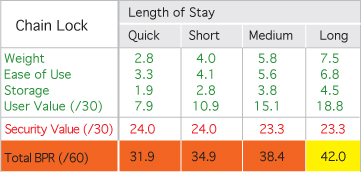Design Responses > About Locks > Typology
Chain With Padllock
This locking system is comprised of a length of chain and either an integrated locking mechanism or a separate padlock or mini D-lock. Applied correctly, the chain is secured to itself with the locking mechanism to create a ‘closed loop’ around the bike frame, wheel(s) and parking furniture.
Chains vary in size, weight and composition. Available locks are similarly diverse and utilise a number of different locking mechanisms, casing and ‘shackle’ designs.
These factors impact significantly on the protection offered by the locking system. Chains with closely spaced links of diameters over 8mm typically offer a high level of protection against ‘leverage’ and make ‘cutting’ more inconvenient as it is harder to insert readily available hand tools between the links to get a purchase on them. Similarly, those locks that offer a ‘closed shackle’, where the metal loop section that secures the chain is for the most part covered by the lock housing, offer the greatest protection as there is a reduced opportunity for a potential thief to gain purchase on the concealed shackle with cutting tools.
Most chains and separate locking mechanisms (e.g. padlocks) are of metal alloy. For example hardened steel is combined with elements such as Boron and Manganese to add strength and reduce weight.
Typically chains are covered with a protective fabric or plastic sleeve to avoid damaging the paintwork of the secured bike and reduce chain corrosion.
A high specification chain and locking mechanism offers a high level of protection to a parked bike. However, high quality chains and locks are typically heavy, difficult and uncomfortable to carry and cannot be easily mounted to a bikes frame.
Chain and padlock systems can be vulnerable to cutting.
Weight
Average weight is 3.38kg. Most common is 2.14-3.1kg.
Dimension
Length from 850-1600mm. Most common is 1100mm.
Usability
The required reach to secure both wheels is important as is the length/weight to wear it on the body. Chains do not have a frame mount. Chain sleeves should be durable/easy to clean/dirt repellent.
Keys and Barrel
Barrel and key, pin and key and combination (no key).
Bikeoff Performance Rating
The table below gives a 'user value' out of thirty, in green, and a 'security value' out of thirty, in red. The total value, out of sixty, gives the overall Bikeoff Performance Rating (BPR). If the Bikeoff Performance rating is in green then the lock is 'user biased', a red rating denotes 'security bias' and a yellow rating indicates an equal performance in relation to user and abuser considerations meaning the lock is a 'good all rounder'. Lock performance is also considered in relation to length of stay to indicate how increased risk (more time parked unattended) impacts on user and abuser values, e.g. lighter, and less secure locks will have a much lower BPR for long stops than for quick stops.

Looking at the table above, user centred values are far outweighed by abuser centred values when considering shorter parking stays. This is due to the difficulties of carrying chain locks due to weight and lack of on bike mounting opportunities. However, the chain lock performs well in terms of resistance to attack by thieves, and for long stays, the inconvenience of portability and weight is balanced by the resistance to abuse, making the chain lock a good solution for long stay locking.
Useful References
www.weblinkinfull.com